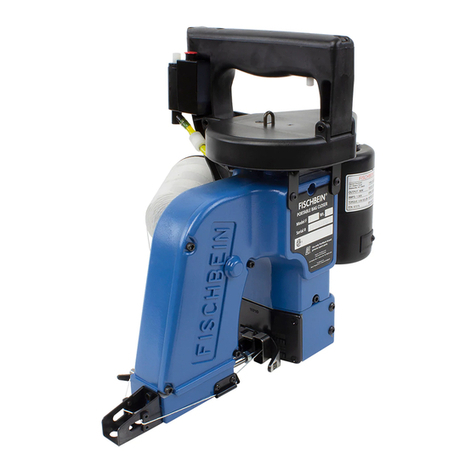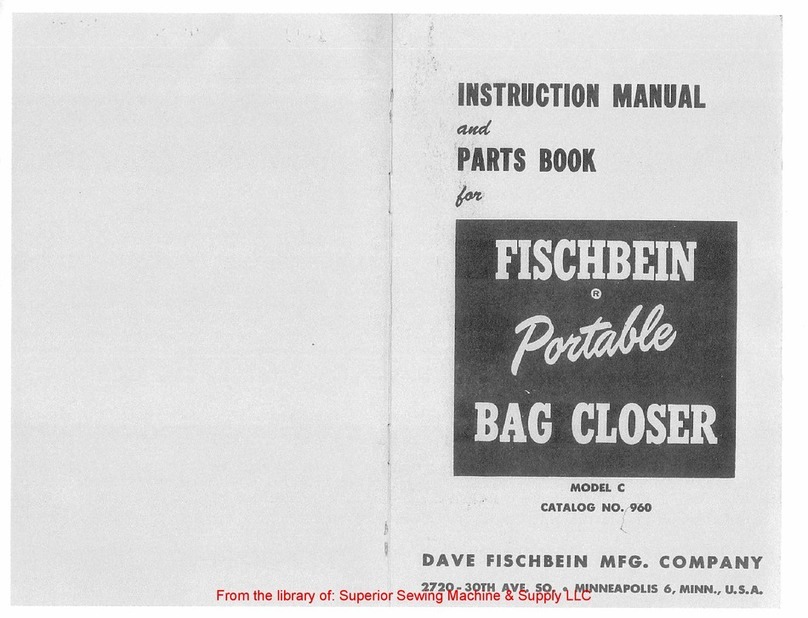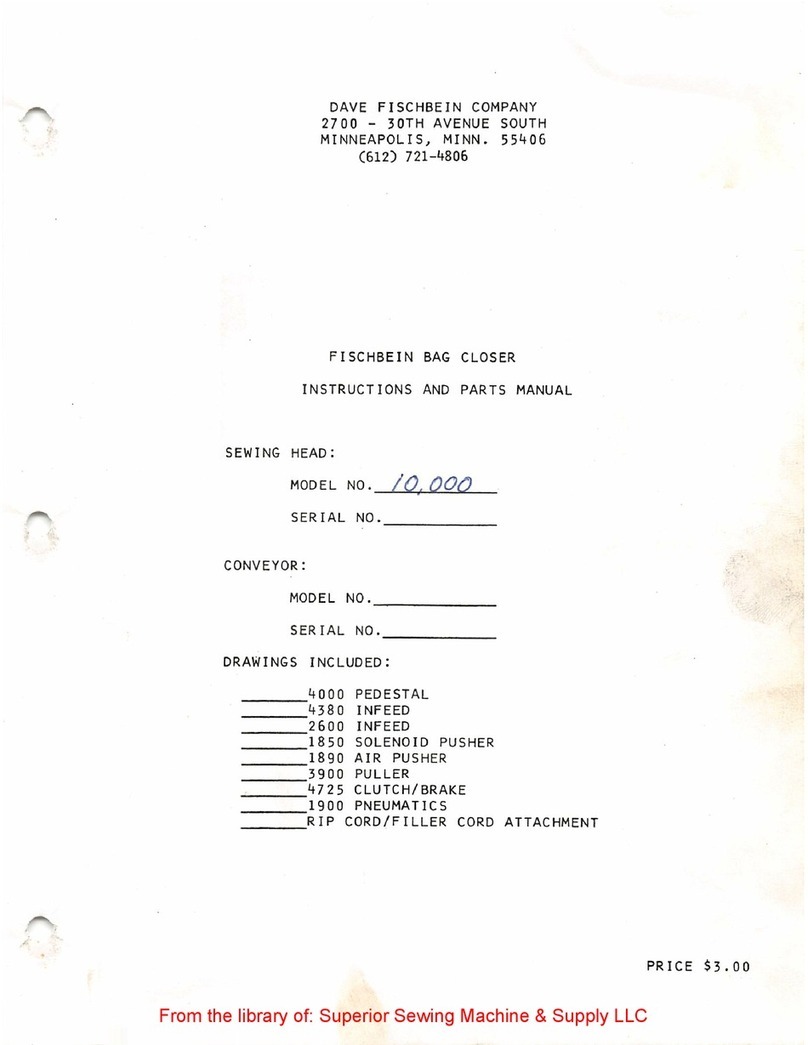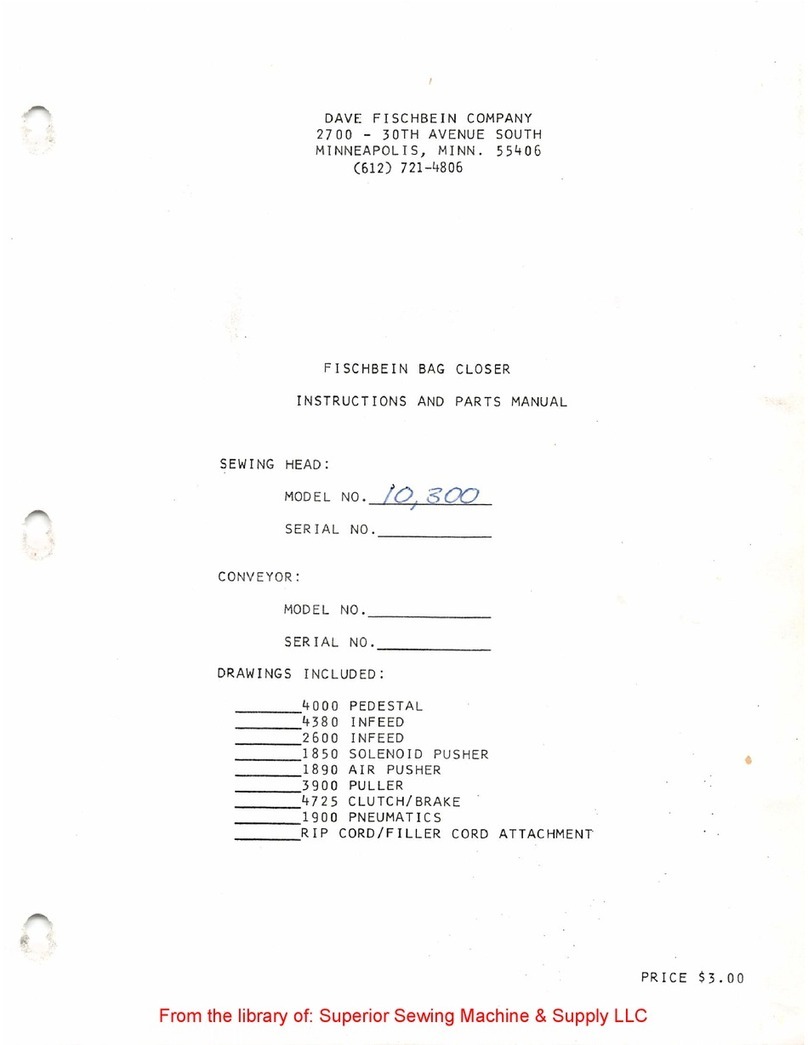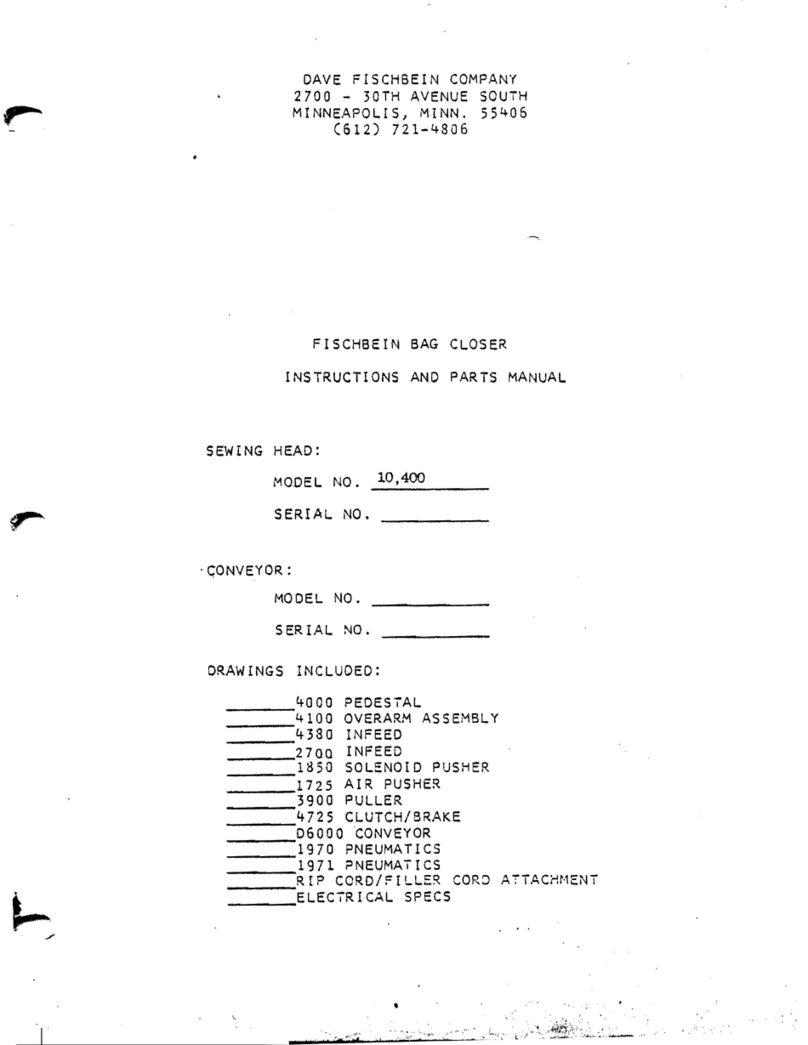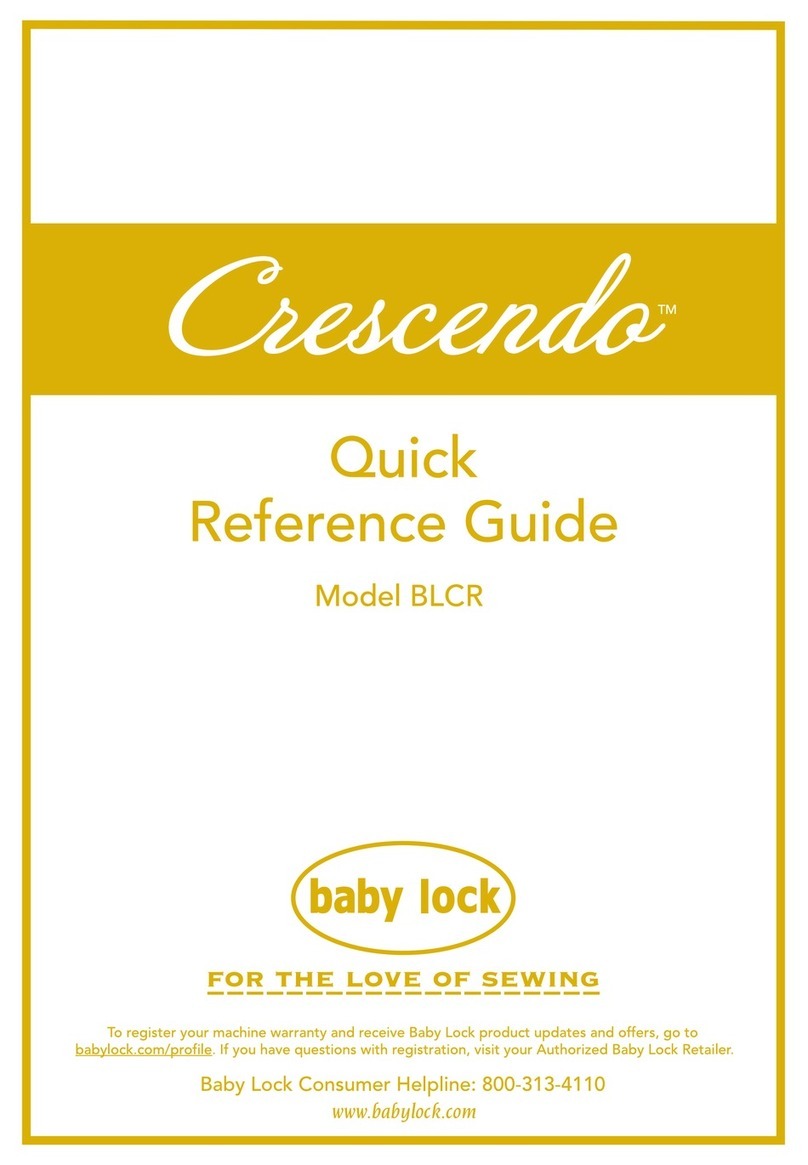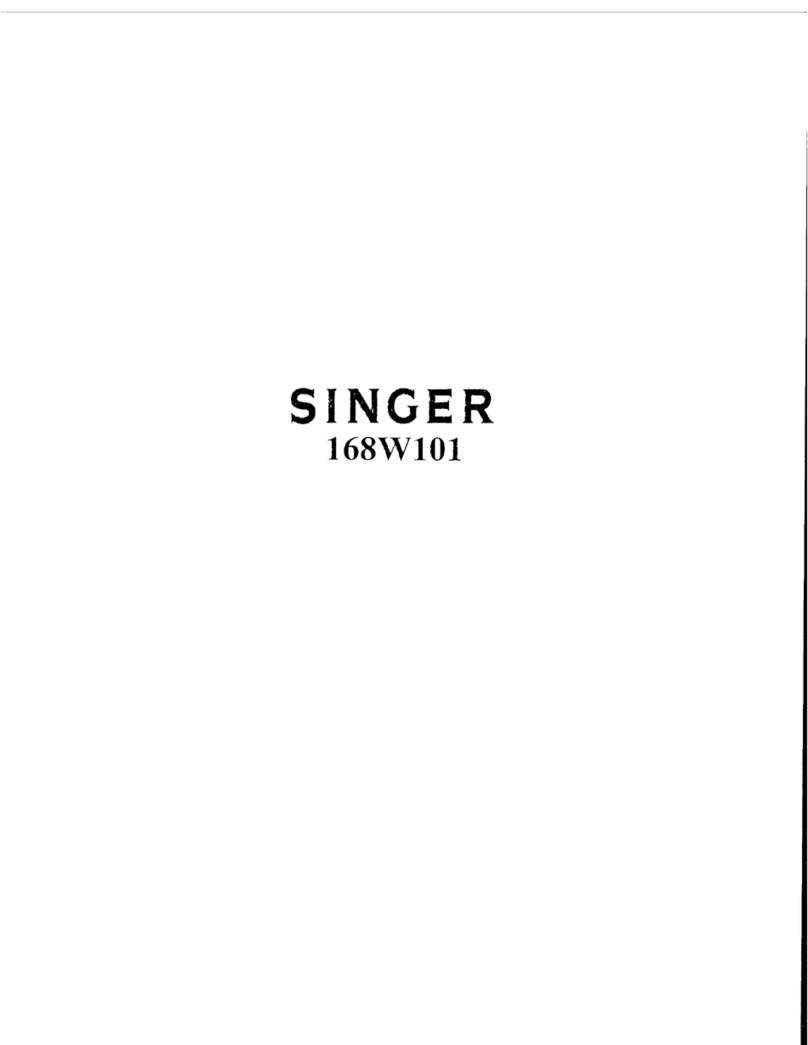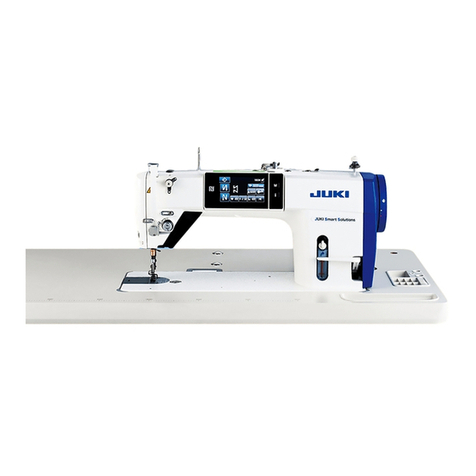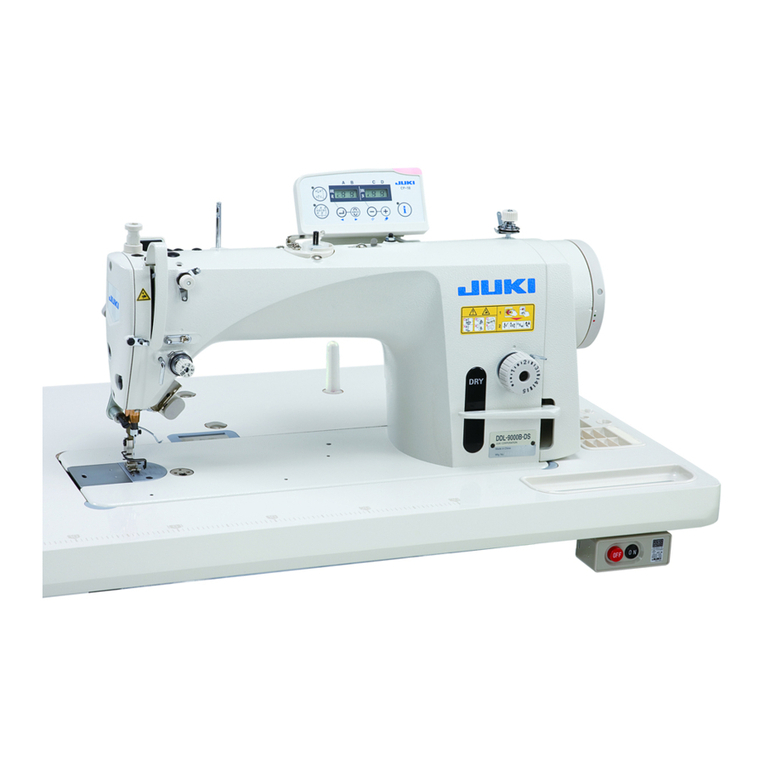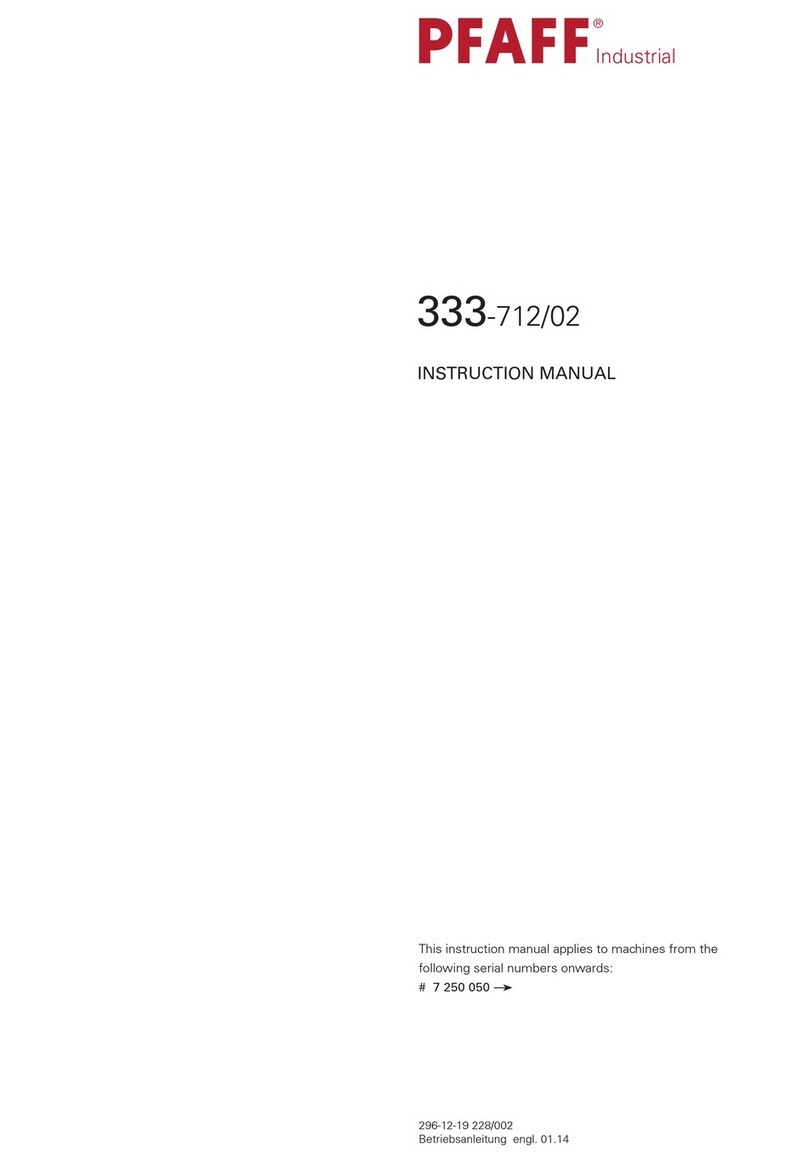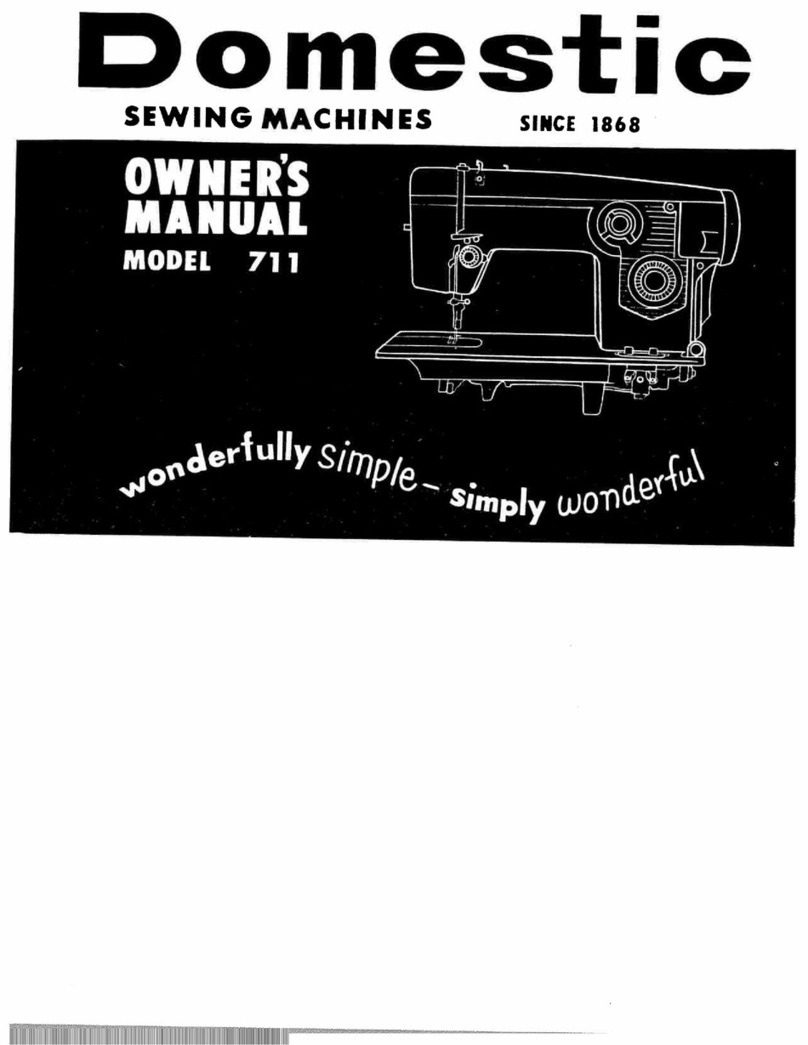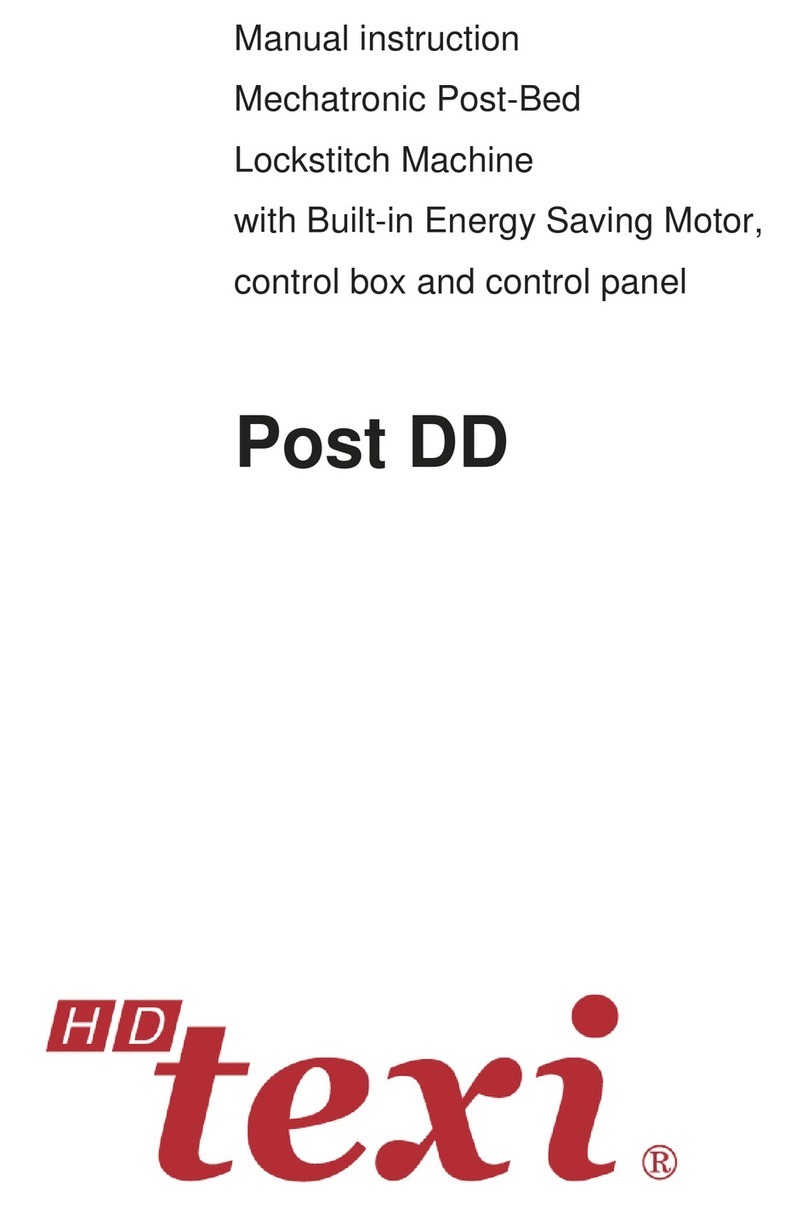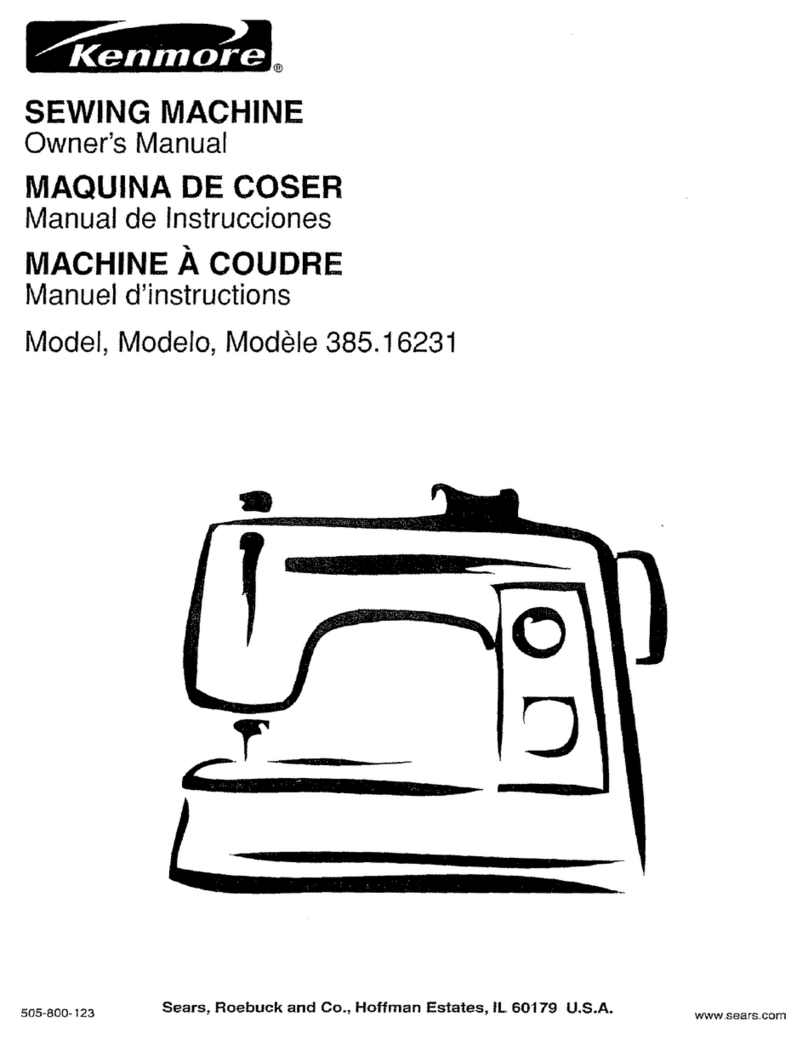FISCHBEIN Empress Series User manual

FISCHBEIN
Model100&101
EmpressSeries
SewingHead

FISCHBEIN®MODELS 100 & 101 EMPRESS™ SERIES SEWING HEAD
OPERATOR’S MANUAL
REV. H 2005 / 11
1
TABLE OF CONTENTS
Page
Corporate Statement ......................................................................... 2
1. Introduction ............................................................................... 3
1.1 System Description ............................................................ 3
1.2 Warnings ………………………………………………………………………. 4
1.3 Characteristics ……………………………………………………………….. 5
2. Installation ………………………………………………………………………………. 7
2.1 Unpacking Procedures …………………………………………………….. 7
2.2 Drive motor recommendations…………………………………………… 7
2.3 Mounting the Sewing Head ………………………………………………. 8
2.4 Lubrication …………………………………………………………………….. 10
2.5 Maintenance ………………………………………………………………….. 11
2.6 Start up recommendations ……………………………………………… 13
2.7 Consumables …………………………………………………………………. 13
3. Machine Adjustments ……………………………………………………………… 13
3.1 Threading the sewing head …………………………………………….. 13
3.1.1. Needle and Looper Thread ……………………………… 13
3.1.2. Filler Cord (Optional) ………………………………………. 15
3.2 Thread tension adjustment ………………………………………………. 16
3.3 Stitch length adjustment …………………………………………………. 18
3.4 Cork seal replacement ……………………………………………………… 19
3.5 Needle replacement ………………………………………………………... 20
3.6 Feed dog replacement ……………………………………………………… 20
3.7 Throat plate replacement ………………………………………………… 21
3.8 Presser foot pressure adjustment ……………………………………... 21
3.9 Fine tuning of the sewing machine ……………………………………. 22
3.10 Tape/Thread Clipper Adjust (model 101 only) ……………………. 28
3.11 Installing new blades (model 101 only) ……………………………… 29
3.12 Mounting & Adjusting the Rotary Air Knife (model 100 only) … 30
3.13 Using the Gauge ………………………………………………………………. 33
3.14 Sewing speed adjustment ………………………………………………… 34
4. Speed tables …………………………………………………………………………….. 39
4.1 English System ……………………………………………………………….. 39
4.2 Metric System ………………………………………………………………… 40
5. Opening a sewn bag ………………………………………………………………… 41
6. Troubleshooting ……………………………………………………………………….. 42
7. Spare Parts List ………………………………………………………………………… 46
8. Drawings and Parts Lists ………………………………………………………….. 47
9. Machine Set Up Parts Lists ………………………………………………………. 77
9.1 Model 100 ……………………………………………………………………… 77
9.2 Model 101 ……………………………………………………………………… 78
10. Safely Disposing of a Sewing Head ………………………………………… 78

FISCHBEIN®MODELS 100 & 101 EMPRESS™ SERIES SEWING HEAD
OPERATOR’S MANUAL
REV. H 2005 / 11
2
READ
READ THIS MANUAL BEFORE INSTALLING, OPERATING OR
PERFORMING MAINTENANCE ON THE MODEL 100 OR 101
EMPRESS™ SEWING HEAD
.
CORPORATE STATEMENT
The Fischbein Company is a premier packaging company that specializes in bag closing
systems. The original one-man business, founded and established by Dave Fischbein in Minneapolis,
Minnesota in 1910, has now grown to an international firm recognized as the global leader in bag
closing technology which manufactures a variety of state-of-the-art bag closing and handling
machines for diverse packaging applications. Fischbein’s first portable sewing machine for bag
closing was developed over 50 years ago and is still widely used throughout the world for a variety
of bag closing applications. Through our bag sewing, closing and sealing technologies, Fischbein
offers automated solutions for nearly every powder and bulk material packaging requirement.
The product line has greatly expanded from those early days, and the company continues to
lead the industry in helping customers increase productivity through improved product performance
with efficient, up-to-date automated packaging solutions.
A worldwide network of distributors assists our customers in meeting their technological
requirements and their business objectives. Orders, questions and comments can be addressed to
Fischbein through the worldwide web at www.fischbein.com or by writing or calling our North
American or European offices:
North American Office Main European Office
Fischbein Company Fischbein SA
151 Walker Road Paepsem Business Park
Statesville, NC 28625 Boulevard Paepsem 18B
Phone: (704) 871-1159 1070 Brussels, Belgium
FAX: (704) 872-3303 Phone: 32-2-521-01-94
FAX: 32-2-520-33-90

FISCHBEIN®MODELS 100 & 101 EMPRESS™ SERIES SEWING HEAD
OPERATOR’S MANUAL
REV. H 2005 / 11
3
1. INTRODUCTION
The contents of this manual are considered to be proprietary and confidential to
FISCHBEIN AND SHOULD NOT BE REPRODUCED WITHOUT PRIOR WRITTEN
PERMISSION FROM FISCHBEIN.
Nothing contained in this document is intended to extend any promise, warranty or
representation, expressed or implied, regarding the FISCHBEIN products described herein. Any
such warranties or other terms and conditions of products shall be in accordance with the standard
terms and conditions of sale for such products, which are available upon request.
FISCHBEIN reserves the right to make changes and improvements to products without
notice and without incurring any obligation to make such changes or add such improvements to
products sold previously.
The use of repair parts other than those included within the FISCHBEIN approved parts list
may create hazardous conditions over which FISCHBEIN has no control. Therefore, FISCHBEIN
cannot be held responsible for equipment in which non-approved repair parts are installed.
1.1 SYSTEM DESCRIPTION
The Fischbein 100 and 101 sewing heads are heavy duty, commercial sewing machines. These
heads sew bags of different materials, such as plastic, woven polypropylene, multi- wall paper
bags, composite bags, jute bags and so forth.
For proper operation, these heads are normally mounted on Fischbein double pedestal stands and
conveyor systems. These enable adjustment of the system for bag height and bag speed through
the system. A variety of infeeds and other special attachments (such as a rotary knife and a needle
cooler) are available to enhance and support the operation of the head.
Model 100
This model is intended for standard sewing, two-thread applications. Uses the standard knives; no
rotary air knife.
Model 100LV
Standard 100 head with rotary air knife at 24 VAC.
Model 100HV
Standard 100 head with rotary air knife at 115 VAC.
Model 100DC
Standard 100 head with rotary air knife at 24 VDC.
Model 101
This model is intended for two or single-thread applications, using tape or pull tape attachments.

FISCHBEIN®MODELS 100 & 101 EMPRESS™ SERIES SEWING HEAD
OPERATOR’S MANUAL
REV. H 2005 / 11
4
1.2 WARNINGS
• The model 100 and 101 sewing heads are driven by strong motors, contain moving parts and have
pinch points and sharp edges. Therefore, a certain amount of technical knowledge and familiarity
with this type of equipment are required to operate and maintain the system. Proper eye, hand and
foot protection must be worn while working with the 100 and 101 sewing heads.
• The sewing head is not a stand-alone machine; therefore, care must be taken to provide the correct
drive system and proper protection from the drive components. You should follow the
recommendations in the manual about the drive system.
• Replacement of the Connecting Needle Drive Rod (pages 52-55; Item 20: part#31020) must be
performed by an authorised Fischbein representative, equipped with the special tools necessary.
• Read the manual carefully before making any changes to the sewing head.
• Always use genuine Fischbein spare parts (including Fischbein Lubricating Oil and
Fischbein Oil Filters). Our parts are specifically designed for Fischbein equipment to
provide optimum performance and safety. Use of non-Fischbein parts can void the product
warranty.
• Turn off and lock out air and power sources when performing maintenance.
• Let the machine do the work. Do not pull the bag or the materials through it.
• Consult Fischbein concerning your specific application and sewing need.
• The sewing head is not suitable to operate in an area where explosive materials are present
(explosive gas, vapors, powders or liquids).
• When used in a dusty environment, NEMA 12 (IP54) electrical equipment must be used.
• Frequently clean the machine to prevent accumulation of dust. Do this to prevent accumulation of
material that may cause a fire or malfunction.
• When cleaning the optical controls that may come with the sewing head, consult the accompanying
manuals from the optical manufacturer. These additional manuals can be found in the electrical
control box with the electrical schematics.
• Any sources of leaks of the machine’s lubricating oil must be repaired immediately to prevent
possible contamination of the product being packed and safety hazards around the system.
• When cleaning the sewing head, use only recommended Fischbein cleaning solvent 5-101.
• Do not use aggressive cleaning products as they may damage the rubber seals.
• When in doubt about operation, troubleshooting and maintenance of the sewing head, consult your
dealer or local Fischbein representative.
• Other specific warnings appear throughout this manual.

FISCHBEIN®MODELS 100 & 101 EMPRESS™ SERIES SEWING HEAD
OPERATOR’S MANUAL
REV. H 2005 / 11
5
1.3 CHARACTERISTICS
Maximum speed: 1800 RPM
Stitch length: 2 – 4 stitches per inch
Machine Weight: Model 100: 58 lbs. (26,4 kg)
(withrotaryairknife)
Model 101: 64 lbs. (29,1 kg)
(with Tape Clipper)
Shipping Weight: Model 100: 61 lbs. (27,7 kg)
(withrotaryairknife)
Model 101: 67 lbs. (30,5 kg)
(with Tape Clipper)
Oil: 1 qt (0.95 litres)
Rykon #68 Oil (#10200)
Maximum speed with a stitch length of 4 stitches per inch is 1800 RPM.
(Refer to Speed Tables, page 39)

FISCHBEIN®MODELS 100 & 101 EMPRESS™ SERIES SEWING HEAD
OPERATOR’S MANUAL
REV. H 2005 / 11
6

FISCHBEIN®MODELS 100 & 101 EMPRESS™ SERIES SEWING HEAD
OPERATOR’S MANUAL
REV. H 2005 / 11
7
2. INSTALLATION
2.1 UNPACKING PROCEDURES
Every Fischbein sewing head is packaged to protect the unit during normal shipping, storage and
handling. Each sewing head is packed in a corrugated box with cardboard padding surrounding it.
It is then taped shut. Before the unit is unpacked, inspect the box for any signs of damage incurred
during shipping. After the unit is unpacked, inspect the sewing head itself for damage. Report any
damages in writing to the shipper and to your authorized Fischbein representative. Be sure to
locate your sewing head’s serial number and model number and record these numbers for future
reference. Reading from left to right, the first six numbers that are stamped on the housing
represent the serial number. The next three numbers represent the model number. The model
number and serial number are also printed on the plate attached to the side of the housing.
The sewing head is very heavy and can be awkward to handle alone. For safety of the installers
and the sewing head, a dolly platform should be used to transport the sewing head.
2.2 DRIVE MOTOR RECOMMENDATIONS
A 1 HP or 746 W motor is recommended.
WARNING: MAXIMUM RPM FOR THE SEWING HEAD IS
1800 RPM AND MUST NOT BE EXCEEDED.

FISCHBEIN®MODELS 100 & 101 EMPRESS™ SERIES SEWING HEAD
OPERATOR’S MANUAL
REV. H 2005 / 11
8
2.3 MOUNTING THE SEWING HEAD
Due to the size and weight of the sewing head, a cart should be used to transport it. It is best to have a
couple of installers handling the sewing head. Be sure to hold it by the main housing.
The sewing head is attached to the overarm assembly by a mounting plate, which mounts to the back
of the housing with three hex head bolts (Illustration 2). It is extremely important that these bolts be
securely tightened to the sewing head.
Refer to Illustrations 1 and 2. The mounting plate attaches to the overarm assembly with two
hinges. The hinges allow for easy access to various areas of the sewing head as well as the cooling
fan (optional). When the sewing head is rotated into the closed position, the outer swinging edge of
the mounting plate will come to rest on two jack bolts. The jack bolts are used to provide the needed
support during use and enable the latch pin to firmly hold the plate. The mounting plate is locked into
the closed position with a latch pin, which is pushed in and rotated to secure the mounting plate.
(Illustration 3) The locking rod passes through a hole in the sewing frame and then through one in
the mounting plate, when in the closed position.
Illustration 1
(Shown with Cooling Fan Option)

FISCHBEIN®MODELS 100 & 101 EMPRESS™ SERIES SEWING HEAD
OPERATOR’S MANUAL
REV. H 2005 / 11
9
If the jack bolts are not properly adjusted, the sewing head can vibrate possibly causing damage or
other parts to come loose. The jack bolts must be raised or lowered so that they come into firm
contact with the mounting plate. Both bolts come with a lock nut to keep them in position.
The jack bolts are pre-set at the factory for the mounting plate that accompanies the sewing system.
The jack bolts will only have to be adjusted if they become loose or if replacing the plate. To adjust
the jacks, loosen the lock nuts and turn the jack bolts clockwise for about five turns. Rotate the plate
into the closed position until it comes into contact with the jacks and then use the latch pin to secure
the plate. The pin will probably rotate with ease and not actually tighten when turned. Gradually
keep trying the latch pin, while turning the lower jack in increments, couterclockwise. The ideal
setting for the lower jack is when the latch pin tightens firmly before it has rotated the full 90o.
(Illustration 3) Use the lower lock nut to hold it in position.
Gradually turn the top jack counterclockwise until it comes into contact with the plate, when it is in
the closed position, but not locked with the pin. Unscrew the top jack one additional rotation. Lock
the top jack into position using the lock nut. When the plate is in the closed position and secured into
place, the latch pin will tighten completely before rotating the entire 90oand press firmly on the jack
bolts.
Illustration 2 (Bottom View; sewing head in closed position)

FISCHBEIN®MODELS 100 & 101 EMPRESS™ SERIES SEWING HEAD
OPERATOR’S MANUAL
REV. H 2005 / 11
10
2.4 LUBRICATION (WARNING)
Refer to Illustration 5. The sewing head is delivered with
a screw in the breather plug. Remove this screw before
starting up the head. Failure to remove this will result in
build up of internal pressure and consequent damage to
seals and other components with possible injuries to the
operator.
The sewing head is filled at the factory with oil (1 qts. or
0,95 litres). Rykon #68 (#10200)
NOTE: No substitution oils are accepted. Use of any
other oil will void the product warranty.
Pre-start up checks:
Check oil level (indicated on the oil window on the left side of the
machine). (Illustration 4)
Check for evidence of oil leaks. If any is found, perform the appropriate repair.
After a few seconds, the oil pressure gauge should indicate a
pressure between 15 PSI (1 bar) and 40 PSI (2,8 bar).
WARNING: Do not run the machine with oil pressure below
15 PSI (1 bar) or above 40 PSI (2,8bar).
Illustration 4
Illustration 3

FISCHBEIN®MODELS 100 & 101 EMPRESS™ SERIES SEWING HEAD
OPERATOR’S MANUAL
REV. H 2005 / 11
11
Replace the oil filter every 500 working hours (see Section 2.5).
Replace the oil every 500 working hours (see Section 2.5).
Approximately 1 qt or 0.95 litres will adequately fill the machine. Rykon #68 oil (ref.
10200) must be used.
Check the oil level when the machine is operating and the pressure is in the specified
range 15-40 PSI (1-2.8 bar). NOTE: The pressure must be checked after the machine has
fully warmed up (1.5-2.0 hours of operation).
In the event the oil level falls below the marker line, add oil until level is met.
2.5 MAINTENANCE:
NOTE: A certain amount of technical knowledge and training is required to perform any
maintenance on Fischbein sewing heads.
DAILY
1. Keep the machine free of dust.
2. Clean with compressed air, using an OSHA approved air nozzle or with a vacuum
cleaner.
3. Check all seals for indications of oil leaks before start up.
4. Lubricate knife blades and presser foot hinges manually with standard lubricating oil.
Wipe all excess oil from parts.
5. Keep optical sensors clean according to their individual manual instructions.
6. Thoroughly, check for loose fasteners and tighten them back into position. If the loose
fastener holds a specific component in place that has a critical setting, refer to the
appropriate section in this manual to establish the correct setting.
PERIODIC - OIL CHANGE
Oil changes are part of periodic
maintenance performed after 500
hours of operation. (Illustration 5)
1. Lock out compressed air and
electrical power so the
machine cannot run.
2. Remove breather plug (A).
3. Unscrew the drain plug (B) in
the bottom cover (C).
4. Drain the used oil into a tray. Illustration 5

FISCHBEIN®MODELS 100 & 101 EMPRESS™ SERIES SEWING HEAD
OPERATOR’S MANUAL
REV. H 2005 / 11
12
5. The drain plug (B) is magnetic. Remove metal particles and dirt sticking to it.
6. Wrap new Teflon® tape around the drain plug (B).
7. Screw the plug (B) into the bottom cover (C).
8. Fill the machine with one quart (0,95 litres) of oil through the breather plug hole (A). A
funnel and flexible tube are provided with the tool kit.
NOTE:
No substitution oils are accepted.
Use of any other oil will void the product warranty.
9. Re-install the breather plug (A).
10. Follow the recommendations for daily operation in Section 2.6.
PERIODIC - OIL FILTER REPLACEMENT
Oil filters are part of periodic maintenance performed after 500 hours of operation. (Illustration
5)
1. Lock out compressed air and electrical power so the machine cannot run.
2. Fill the replaced filter with oil.
3. Use a genuine Fischbein oil filter, ref. 15054.
4. Coat the seal on the new oil filter with a thin film of oil.
5. Remove the old oil filter.
6. Install the new filter (hand tightening is sufficient).
7. Run the sewing head in short, 2 to 3 second cycles until the filter is filled and the
pressure falls in the normal 15 to 40 PSI (1-2,8 bar) range.
Teflon is the registered trademark of DuPont U.S.A.

FISCHBEIN®MODELS 100 & 101 EMPRESS™ SERIES SEWING HEAD
OPERATOR’S MANUAL
REV. H 2005 / 11
13
2.6 START UP RECOMMENDATIONS
2.6.1
Daily use
: Initially, start the machine in short, 2 to 3 seconds cycles until the
correct oil pressure is reached.
2.6.2
Running after prolonged shut down (two months and
over):
Replace the oil and filter and follow procedure 2.5.
2.7 CONSUMABLES
The Fischbein Company recommends using Fischbein cleaning solvent (ref. 5-101), Rykon
#68 oil (ref. 10200), Fischbein oil filter (ref. 15054) and Fischbein sewing thread. Sewing
heads Model 101 use crepe sewing tape, available in a variety of basic colors and widths.
Seals, gaskets, knife blades, belts and any other part subject to normal wear should be
replaced with genuine Fischbein spare parts. If in doubt, contact your Fischbein
representative.
3. MACHINE ADJUSTMENTS
3.1 THREADING THE SEWING HEAD
3.1.1 LOOPER AND NEEDLE THREAD
1. Lock out compressed air and electrical power so the machine cannot run.
2. Refer to Illustration 6, page 14. Thread the needle as shown. A pair of needle nose pliers may
help in threading small areas.
3. The thread at the needle is laced through from machine’s infeed side towards the needle. Let the
thread stick out 4” (102mm) on the other side of the needle.
4. Ensure that the thread runs properly through the thread-tensioning discs B & C.
5. Thread the looper (F) as shown.
6. The thread at the looper (F) must first go through the top hole and then through the bottom hole.
About 4” (102mm) should be left sticking out of the looper. (Illustration 6).
7. To complete a chain off, a piece of bag material should be placed between the presser foot and
the throat plate before running the machine. Loosen the sewing head drive belt tension by
unlocking the drive motor. (System Illustration, page 6, #7) Turn the pulley by hand in a
clockwise direction so the sewn bag proceeds forward through at least three complete cycles.
This will start the chaining process. Run the system to clear out the test bag material, before
attempting to run a bag through the system. If this procedure is not followed, it will not start a
chain and the machine might break the needle.
8. A Model 101 tape sewing head must have tape between the presser foot and feed dog to operate.
Check the looper to ensure no thread has accumulated around it.

FISCHBEIN®MODELS 100 & 101 EMPRESS™ SERIES SEWING HEAD
OPERATOR’S MANUAL
REV. H 2005 / 11
14
Illustration 6

FISCHBEIN®MODELS 100 & 101 EMPRESS™ SERIES SEWING HEAD
OPERATOR’S MANUAL
REV. H 2005 / 11
15
3.1.2 FILLER CORD (OPTIONAL)
1. Lock out electrical and pneumatic systems before attempting to thread the filler cord.
2. Follow Illustrations 6, 7 and 8 to thread the
filler cord with the looper and needle thread.
Note that the filler cord does NOT get
threaded through the thread pull off.
3. Once the thread has been threaded through the
Filler Cord Eyelet (Illustration 7), it will be
threaded through the presser foot as shown in
Illustration 8.
4. The bottom of the presser foot is designed with
a channel, which runs from the filler cord hole
to the back of the presser foot.
5. To complete a chain off, a piece of bag
material should be placed between the presser
foot and the throat plate before running the
machine. Turn the pulley by hand in a
clockwise direction so the sewn bag proceeds
forward through at least three complete cycles.
Run the system to clear out the test bag
material, before attempting to run a bag
through the system. If this procedure is not
followed, it will NOT start a chain and the
machine might break the needle.
6. The needle thread should
actually be sewn through the
filler cord. Be sure to leave
about 4 inches (102 mm) of
filler cord (chaining) out past
the back of the presser foot
before running the first bag
through the system.
7. It is very important to keep
the needle thread and the
filler cord separated and not
to let them accidentally twist
together while threading or
running the sewing system.
Illustration 7
Illustration 8

FISCHBEIN®MODELS 100 & 101 EMPRESS™ SERIES SEWING HEAD
OPERATOR’S MANUAL
REV. H 2005 / 11
16
3.2 THREAD TENSION ADJUSTMENT
1. Looper thread tension (A):
The tension on the looper
thread must be light and
even as the thread is
pulled with a steady, even
motion. If the tension is
not even, or a large force
is required to pull the
thread, the source of the
problem must be found
and corrected before
running the machine.
2. Needle thread tension (B):
Illustration 9. The needle thread tension is adjusted with the thread tensioner (B). The needle
thread tension should put a noticeable drag on the thread. Tension also varies with stitch length
and thickness of material to be sewn.
This adjustment can be combined with thread pull off positioning (D). On the needle arm, thread
tensioner (C) prevents thread pulled by the thread pull off from sagging too close to the needle.
Tension is very slight and the adjustment is fixed. Factory settings of tension are made for a 4-
ply paper bag with a stitch length of 2.5 stitches per inch (10 mm per stitch) using Fischbein
synthetic thread 12/5, unless otherwise specified when ordered, which is valid in most cases.
Illustration 9

FISCHBEIN®MODELS 100 & 101 EMPRESS™ SERIES SEWING HEAD
OPERATOR’S MANUAL
REV. H 2005 / 11
17
3. Thread pull off adjustment
Illustration 10 shows the factory setting. This is suitable in many cases.
For thin materials, distance Xmust be shorter.
For thick materials, distance Xmust be larger.
If the stitch is too loose, try first to adjust with the needle thread tension before shortening the
distance Xof the thread pull off.
Illustration 10

FISCHBEIN®MODELS 100 & 101 EMPRESS™ SERIES SEWING HEAD
OPERATOR’S MANUAL
REV. H 2005 / 11
18
3.3 STITCH LENGTH ADJUSTMENT
The standard factory setting of the stitch length is 3/8” (10 mm per stitch). Other stitch lengths
can be set according to customer requirements. If a change is needed, please follow the
procedure below:
1. Be sure the feed dog is down below the surface of the throat plate, by rotating the drive pulley
clockwise. (Illustration 12)
2. Stand the sewing head on its drive pulley so that no oil can flow out when removing the bottom
cover (C, Illustration 5 and 11). Block the head to prevent it from rotating on its pulley.
3. Remove the oil drain plug (Illustration 11) from the bottom cover (C). The drain hole will
provide access to the socket cap screw (A), used in adjusting the stitch length.
4. With a 3/16” allen wrench, loosen (but do not remove) the socket cap screw (A). (Illustration
11) The screw may fall into the housing if it is removed.
5. The stitch length is changed by moving link (D) (Illustration 11) along the slot in link (B).
Moving link (D) toward the throat plate shortens the stitch. Moving it away from the throat
plate lengthens it.
6. Tighten the socket cap screw (A), but not fully yet.
Illustration 11
(
Bottom Plate View
)

FISCHBEIN®MODELS 100 & 101 EMPRESS™ SERIES SEWING HEAD
OPERATOR’S MANUAL
REV. H 2005 / 11
19
7. To check the stitch length, tilt the sewing head enough to rotate the drive pulley, without
allowing the oil to leak out of the drain hole. Put a sample piece of bag under the presser foot.
Rotate the drive pulley clockwise through ten cycles and remove the bag sample. Calculate the
stitch length and make necessary adjustment to the socket cap screw (A). (Section 3.14.3, pages
37-38, #5)
8. Tighten socket cap screw (A) after obtaining a correct setting. Wrap new Teflon® tape around
the drain plug, and install it back into place.
9. Stitch length can vary between 2 to 4 stitches per inch (6,4 mm to 12,7 mm per stitch).
10. Changing the stitch length also involves re-synchronising the sewing head to the conveyor and
the infeed (see Section 3.14, page 34).
3.4 CORK SEAL REPLACEMENT
1. Referring to Illustration 11 and 12, check the cork seal located between plate (C) and housing
(D), whenever plate (C) is removed.
2. Replace the seal (part number 10093) if it is damaged. Grease can be applied.
Illustration 12
Other manuals for Empress Series
1
This manual suits for next models
2
Table of contents
Other FISCHBEIN Sewing Machine manuals
